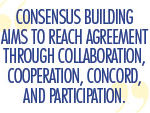Getting a team to reach a mutual decision can be more than challenging. Individual members have viewpoints that are influenced by their paradigms, experiences, and personalities. We learned in part one of this article that voting gains only the majority of acceptance and that it may be better to gain a consensus to be successful as a team. Let’s take a closer look at consensus building.
CONSENSUS BUILDING
If voting is a Win-Lose, how do we move the team to a Win-Win choice where everyone supports the end decision? The answer is a process called Consensus Building. Transforming various viewpoints, perspectives, and priorities into one uniform decision requires an understanding of an approach that builds consensus. The process allows various stakeholders to work together to develop a mutually acceptable solution.
Consensus Building is also known as collaborative problem solving or collaboration and can be applied to even the most complex challenges.

Consensus means coming to an agreement. Creating consensus in a team situation means finding an agreement satisfactory enough that all team members can support it, with no member overtly opposing it. It is better to use a facilitator to handle the team dynamics.
Consensus includes:
- Gathering opinions
- Listening responsively (Quaker Talk—listen with no response)
- Debating ideas and differences
- Everyone expresses their concerns
- Reaching a compromise, which means not getting all you want
- Arriving at a settlement decision that everyone “can live with and support”
It is not a unanimous vote, majority rule, one-person rule, or bargaining.
The objective in Consensus Building is to allow everyone an opportunity to express their concerns for an approach, and present the rationale for their recommendation. This dialog allows people to be heard, for and against certain recourses or alternatives. This approach provides a forum where disagreement can be shared in an unemotional manner by taking the time for all to be heard. So, instead of jumping to a majority-minority vote, time is allowed for discussion with the intent to reach a compromise that everyone can live with. Harmonious group decisions made by consensus seek resolutions that are satisfactory to ALL group or team members and meet all of their concerns.
The objective is for all participants to sanction the decision as mutually acceptable by all, with the premise that some will be more supportive than others but “I can live with it.” Group members treat each other equally and solicit the input of all participants, so they have “sweat equity” and ownership in the end product or decision(s). The dialog might sound like, “Dave, I know this isn’t exactly what you wanted but can you live with it to support the group’s efforts?”
METHODS TO BUILD CONSENSUS
Consensus Building methods may include Brainstorming, Nominal Group Technique (multiple passes between people narrowing options each time), and Multivoting (where participants have a certain number of votes to dispense). Many of these can be used to narrow the choices down but discussion tends to be the primary means to reach consensus.
But making decisions through Consensus Building is not necessarily ideal or even appropriate in many cases. The downsides are that, in an effort to satisfy everyone, the decision may reach the lowest common denominator, therefore, producing less than optimal results. Also, Consensus Building can be very time consuming to involve everyone. This can be problematic when time is a premium and urgency is needed for a decision.
COMPROMISE THROUGH COLLABORATION
When the end decision needs to be made and we need all the participants to own that decision, Consensus Building is a way to reach compromise through collaboration. ■
About the Author
Preston Ingalls is president and CEO of TBR Strategies, LLC, a Raleigh, North Carolina-based maintenance and reliability firm specializing in the construction and oil and gas industries. Preston can be reached at pingalls@tbr-strategies.com, or visit www.tbr-strategies.com.
_________________________________________________________________________
Modern Contractor Solutions, September 2017
Did you enjoy this article?
Subscribe to the FREE Digital Edition of Modern Contractor Solutions magazine.



